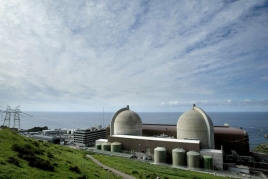David R. Baker is a San Francisco Chronicle staff writer. Email: dbaker@sfchronicle.com Twitter: @DavidBakerSF
California’s last nuclear plant to close after unanimous vote by regulators

California’s last nuclear power plant — Diablo Canyon, whose contentious birth helped shape the modern environmental movement — will close in 2025, state utility regulators decided Thursday.
The unanimous vote by the California Public Utilities Commission will likely bring an end to nuclear energy’s long history in the state, even as California fights to reduce the greenhouse gas emissions that come from conventional power plants. State law forbids building more nuclear plants in California until the federal government creates a long-term solution for dealing with their waste, a goal that remains elusive despite decades of effort.
“With this decision, we chart a new energy future by phasing out nuclear power here in California,” said commission President Michael Picker. “We’ve looked hard at all the arguments, and we agree the time has come.”
Diablo Canyon’s planned shut-down is the latest blow to America’s nuclear power industry, beset by plant closures and the cancellation of proposed reactors.
Pacific Gas and Electric Co. opened Diablo Canyon in 1985 on a coastal bluff in San Luis Obispo County despite fierce opposition from environmentalists convinced that the plant’s proximity to fault lines — one of them just 650 yards away — posed a lethal risk. Waves of demonstrations, including one addressed by a young Gov. Jerry Brown, and mass arrests failed to block the plant.
But now, radical changes in California’s electricity market, including the rapid rise of renewable power, threaten to make the plant uneconomical to run. PG&E in 2016 reached an agreement with environmental groups and labor unions to retire Diablo Canyon when its two federal operating licenses expire in 2024 and 2025 and replace its output with renewable power and energy efficiency measures.
While the utilities commission agreed with the larger goal of closing the plant, the commission jettisoned much of the agreement hammered out among PG&E and its negotiating partners.
The commission’s decision, for example, did not include $85 million of ratepayer funds that PG&E wanted to spend in the plant’s neighboring communities to help wean them off the tax income currently provided by the plant.
“We have an entire local economy built around Diablo Canyon,” said Chris Finarelli, chief of staff for state Assemblyman Jordan Cunningham (R-Templeton, San Luis Obispo County), speaking before the vote. “If the economic impact funds are not included in today’s decision, the effect on local communities will be severe.”
The decision also gave PG&E less money — $222.6 million instead of $363.4 million — to retain Diablo Canyon’s 1,500 highly skilled employees and retrain some of them for the decommissioning process. And it provided no firm requirement that the plant’s output be replaced with carbon-free resources.
“The decision undermines what should have been an inspiring model for the rest of the country and the world on best practices for planning for the closure of giant, expensive, and inflexible nuclear plants,” said Ralph Cavanagh, co-director of the energy program at the Natural Resources Defense Council, one of the groups that negotiated the closure agreement with PG&E.
The commission, he said, did not seem to appreciate the amount of thought the negotiating partners, some of which had a long history of fighting PG&E, put into the details of their agreement.
“It was a joint proposal by numerous parties that have never agreed on anything,” Cavanagh said.
PG&E said it would meet with its partners to decide how to proceed.
“While we are disappointed that they did not approve the full employee retention program, as well as the community impact mitigation and energy efficiency programs, we are appreciative that the CPUC took the positive step to increase the amount of funding for employee retention beyond their original proposed decision,” PG&E spokesman Blair Jones said.
While anti-nuclear demonstrators mobilized against Diablo Canyon’s construction and commissioning, pro-nuclear advocates in recent years organized to keep it open.
They saw the plant as essential to California’s fight against global warming. As the state’s largest power plant, Diablo Canyon supplies 9 percent of California’s electricity while producing no greenhouse gases.
California’s greenhouse gas emissions, which have fallen almost every year since peaking in 2004, rose in 2012 following the abrupt closure of the San Onofre Nuclear Generating Station north of San Diego. (That year’s drought, which cut the output of hydroelectric dams, also helped push up emissions.)
But proponents were unable to convince state legislators to get involved, said Michael Shellenberger, a pro-nuclear writer and activist in Berkeley.
“It’s a brick wall,” said Shellenberger, president of the Environmental Progress non-profit group, whose experience trying to save Diablo inspired him to run for governor. “I tried to meet with everyone I could, Democrats and Republicans, and it was useless. There was no interest.”




